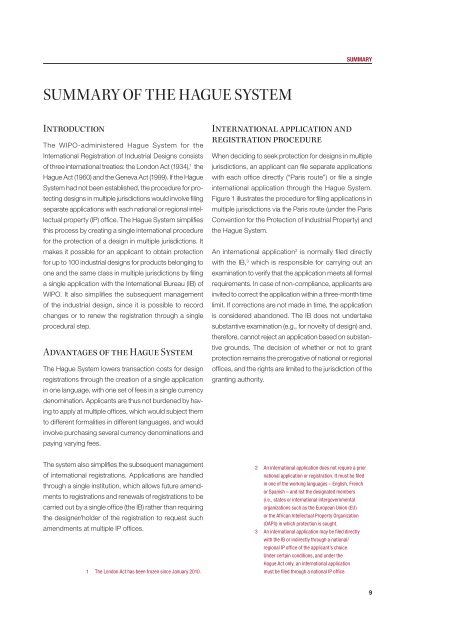wEyG1
wEyG1
wEyG1
Create successful ePaper yourself
Turn your PDF publications into a flip-book with our unique Google optimized e-Paper software.
SUMMARY<br />
SUMMARY OF THE HAGUE SYSTEM<br />
Introduction<br />
The WIPO-administered Hague System for the<br />
International Registration of Industrial Designs consists<br />
of three international treaties: the London Act (1934), 1 the<br />
Hague Act (1960) and the Geneva Act (1999). If the Hague<br />
System had not been established, the procedure for protecting<br />
designs in multiple jurisdictions would involve filing<br />
separate applications with each national or regional intellectual<br />
property (IP) office. The Hague System simplifies<br />
this process by creating a single international procedure<br />
for the protection of a design in multiple jurisdictions. It<br />
makes it possible for an applicant to obtain protection<br />
for up to 100 industrial designs for products belonging to<br />
one and the same class in multiple jurisdictions by filing<br />
a single application with the International Bureau (IB) of<br />
WIPO. It also simplifies the subsequent management<br />
of the industrial design, since it is possible to record<br />
changes or to renew the registration through a single<br />
procedural step.<br />
Advantages of the Hague System<br />
The Hague System lowers transaction costs for design<br />
registrations through the creation of a single application<br />
in one language, with one set of fees in a single currency<br />
denomination. Applicants are thus not burdened by having<br />
to apply at multiple offices, which would subject them<br />
to different formalities in different languages, and would<br />
involve purchasing several currency denominations and<br />
paying varying fees.<br />
International application and<br />
registration procedure<br />
When deciding to seek protection for designs in multiple<br />
jurisdictions, an applicant can file separate applications<br />
with each office directly (“Paris route”) or file a single<br />
international application through the Hague System.<br />
Figure 1 illustrates the procedure for filing applications in<br />
multiple jurisdictions via the Paris route (under the Paris<br />
Convention for the Protection of Industrial Property) and<br />
the Hague System.<br />
An international application 2 is normally filed directly<br />
with the IB, 3 which is responsible for carrying out an<br />
examination to verify that the application meets all formal<br />
requirements. In case of non-compliance, applicants are<br />
invited to correct the application within a three-month time<br />
limit. If corrections are not made in time, the application<br />
is considered abandoned. The IB does not undertake<br />
substantive examination (e.g., for novelty of design) and,<br />
therefore, cannot reject an application based on substantive<br />
grounds. The decision of whether or not to grant<br />
protection remains the prerogative of national or regional<br />
offices, and the rights are limited to the jurisdiction of the<br />
granting authority.<br />
The system also simplifies the subsequent management<br />
of international registrations. Applications are handled<br />
through a single institution, which allows future amendments<br />
to registrations and renewals of registrations to be<br />
carried out by a single office (the IB) rather than requiring<br />
the designer/holder of the registration to request such<br />
amendments at multiple IP offices.<br />
1 The London Act has been frozen since January 2010.<br />
2 An international application does not require a prior<br />
national application or registration. It must be filed<br />
in one of the working languages – English, French<br />
or Spanish – and list the designated members<br />
(i.e., states or international intergovernmental<br />
organizations such as the European Union (EU)<br />
or the African Intellectual Property Organization<br />
(OAPI)) in which protection is sought.<br />
3 An international application may be filed directly<br />
with the IB or indirectly through a national/<br />
regional IP office of the applicant’s choice.<br />
Under certain conditions, and under the<br />
Hague Act only, an international application<br />
must be filed through a national IP office.<br />
9


